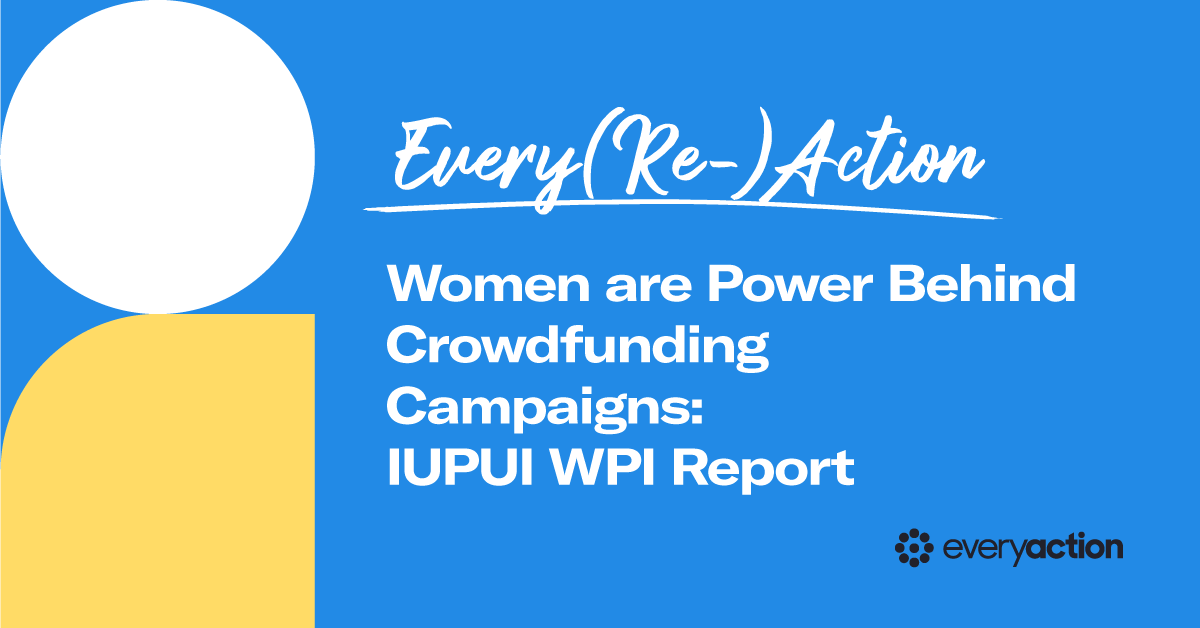Every(Re)Action | Women Power Crowdfunding Campaigns: WPI Report

Crowdfunding, which “by one estimate[…] raised $34.4 billion globally in 2020,” receives significant power from women donors. A new report from the IUPUI Women’s Philanthropy Institute asked the question, “How does gender relate to making crowdfunding donations as a form of charitable giving?” The report’s key findings illuminate how and why women fuel crowdfunding campaigns—and may offer insight into women’s broader perspectives on generosity.
Crowdfunding in Overlapping Disasters
The report, which surveyed a weighted sample of 1,535 American adults, set this context in the introduction:
The COVID-19 pandemic and resulting economic uncertainty disproportionately affected women, resulting in what has been termed the “she-cession.” At the same time, health and economic woes drove a sharp increase in crowdfunding and social media fundraising campaigns for those facing job losses, unexpected medical bills, and more.
In an atmosphere of uncertainty and unprecedented need, this report focuses on women’s crowdfunding contributions as a key giving vehicle. Prior research has shown that, broadly speaking, women are more generous than men. Nontraditional forms of generosity such as crowdfunding also tend to appeal to women donors. This study focuses on the gender dynamics of crowdfunding donors.
Who is Giving through Crowdfunding?
“Overall,” says the WPI report, “women and men contribute to crowdfunding campaigns at similar rates.” This means that approximately one in three people contribute to crowdfunding campaigns in a typical year, and just over 40 percent of people report having ever contributed to crowdfunding projects. However, a difference emerges when social media is the channel for giving: more women than men “give charitably via social media in a typical year.”
The report’s further findings focus on these women donors’ demographics and rationale for giving.
Women’s Crowdfunding: Demographics, Direction, and Motivation
The report found that compared to women who don’t give to crowdfunding campaigns, women crowdfunding donors tend to:
- Be younger — the report doesn’t quantify how much younger these donors tend to be, but refers to this segment as “significantly younger.”
- Have higher levels of education — these donors tend to have at least a bachelor’s degree.
- Live in the Western U.S. — “while the geographic regions collected for this study are fairly broad,” comments the report, “the Western region includes technology hubs like Seattle and Silicon Valley.”
- Give to individuals or charitable organizations — women who donated to crowdfunding campaigns were most likely to give to family members or close friends, and least likely to give to for-profit ventures.
- “Cite traditional philanthropic motivations” — nearly 85 percent said they were motivated to give by the belief that their gift would make a difference, while less than 20 percent cited a celebrity ask on or off social media as their reason for giving.
Disaggregating this data by race, the report found that “in a typical year, 33.3% of Black women contribute to a crowdfunding project, compared to 31.2% of Hispanic women and 30.2% of White women.” Additionally, when looking at specific generous behaviors, the report found that Black and Hispanic/Latina women are more likely than white women to give to people they know, give to strangers, and to volunteer — information which “seems to affirm other research indicating that Black women and other historically underrepresented groups tend to give and volunteer more informally rather than donating money or time to a registered charity.”
Our Take
Like other forms of direct giving, crowdfunding isn’t going away anytime soon! Nonprofits can channel some of the appeal of crowdfunding by:
- Segmenting audiences using behavioral and demographic info at the same time for best results — a donor’s gender rarely tells their full story.
- Putting a familiar face on engagement — strategies like P2P can help you raise more for your mission and communicate your impact in a way that resonates with your audiences.
- Using social media strategies to make donation asks and engage supporters — as our recent Survey Report found, social media is a top priority for nonprofits who want to boost their fundraising and engagement results in the near future.


